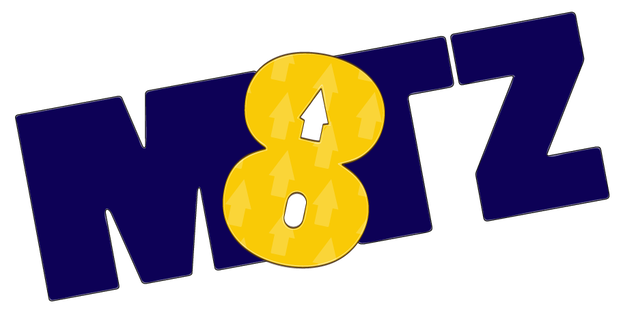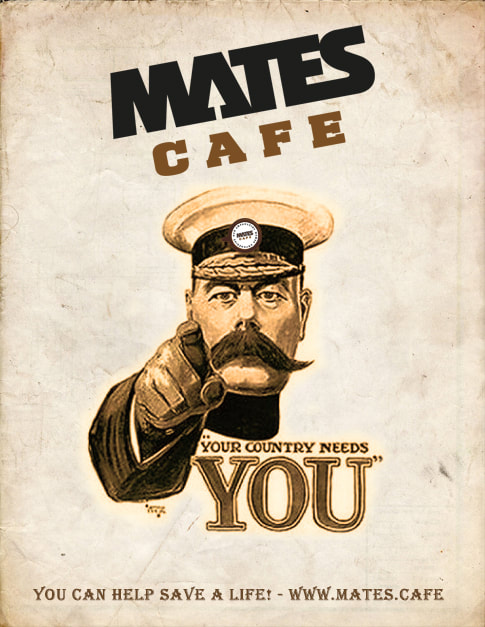You Are Not Alone - MATES Cafe Whakatane NZ
MATES Cafe is a network of everyday people of all cultures and ethnicity (including teens, elders and lgbt+) who are trained to meet with a person in crisis or isolation at a local cafe, and provide emotional support and encouragement.
MATES Cafe will empower your life so you can in turn empower the lives of others in need.
MATES are here:
To help people of all ages, gender, culture, ethnicity and personal beliefs through the challenges and tough times of life including relationship breakdown, depression, anxiety, loss and grief, bullying, loneliness and isolation. MATES are trained to be there for someone in need and helping them through a point of crisis in their life. It's not about therapy, fixing or giving advice, just simply listening and helping them to find new direction in their life.
Whakatane NZ - MATES Cafe Network
|
A Call-Out to ALL!
Can You Spare ONE Hour of Your Life to Save a Life? MATES Cafe is purely about saving lives. Do you realise one person completes suicide every 13 hours in New Zealand because they are unable to stand the emotional trauma they are undergoing, often caused by relationship breakdown. Every 4 minutes 1 New Zealander has suicidal thoughts and needs a MATE to turn to. MATES need your help to drastically lower the suicide rate... are you with us? Saving someones life can be to either:
|
Whakatane
|
|
Whakatane (/fɑːkəˈtɑːni/ fah-kə-TAH-nee; Māori pronunciation: [fakaˈtaːnɛ]) is a town in the eastern Bay of Plenty Region in the North Island of New Zealand, 90 km east of Tauranga and 89 km north-east of Rotorua, at the mouth of the Whakatane River. Whakatane District is the encompassing territorial authority, which covers an area to the south and west of the town, excluding the enclave of Kawerau.
It has an urban population of 18,950, with another 15,250 people living in the rest of the Whakatane District. Of the 34,200 people (June 2013 estimate) in the District,[1] around 40% have Māori ancestry. The District has a land area of 4,442.07 km² (1,715.09 sq mi). Whakatane District was created in 1976.
Whakatane is part of the parliamentary electorate of East Coast, represented by Anne Tolley of the New Zealand National Party. It is the main urban centre of the Eastern Bay Of Plenty sub-region; incorporating Whakatane, Kawerau, and Opotiki the Eastern Bay stretches from Otamarakau in the west, to Cape Runaway in the north-east and Whirinaki in the south. It is the seat of the Bay of Plenty Regional Council, chosen as a compromise between the region's two larger cities, Tauranga and Rotorua.
Whakatane was affected by the 1987 Edgecumbe earthquake.
History Maori Occupation The site of the town has long been populated. Māori pā (Māori fortified village) sites in the area date back to the first Polynesian settlements, estimated to have been around 1200 CE. According to Māori tradition Toi-te-huatahi, later known as Toi-kai-rakau, landed at Whakatane about 1150 CE in search of his grandson Whatonga. Failing to find Whatonga, he settled in the locality and built a pa on the highest point of the headland now called Whakatane Heads, overlooking the present town. Some 200 years later the Mataatua waka landed at Whakatane.[2]
The name "Whakatane" is reputed to commemorate an incident occurring after the arrival of the Mataatua. The men had gone ashore and the canoe began to drift. Wairaka, a chieftainess, said “Kia Whakatāne au i ahau” (“I will act like a man”), and commenced to paddle (which women were not allowed to do), and with the help of the other women saved the canoe.[3]
The region around Whakatane was important during the New Zealand Wars of the mid 19th century, particularly the Volkner Incident. Its role culminated in 1869 with raids by Te Kooti's forces and a number of its few buildings were razed, leading to an armed constabulary being stationed above the town for a short while. Whakatane beach heralded an historic meeting on 23 March 1908 between Prime Minister Joseph Ward and the controversial Māori prophet and activist Rua Kenana Hepetipa. Kenana claimed to be Te Kooti's successor.
European Settlement The Strand, Whakatane-circa 1975 The town was a notable shipbuilding and trade centre from 1880 and with the draining of the Rangitikei swamp into productive farmland from 1904, Whakatane grew considerably. In the early 1920s it was the fastest growing town in the country for a period of about three years and this saw the introduction of electricity for the first time. The board mill at Whakatane began as a small operation in 1939[4] but has grown over the years, it continues operating to this day.
The Whakatane River once had a much longer and more circuitous route along the western edge of the Whakatane urban area, having been significantly re-coursed in the 1960s with a couple of its loopier loops removed to help prevent flooding and provide for expansion of the town. Remnants of the original watercourse remain as Lake Sullivan and the Awatapu lagoon. The original wide-span ferro-concrete bridge constructed in 1911 at the (aptly named) Bridge Street was demolished in 1984 and replaced by the Landing Road bridge.[5]
The area of the town centre around Kakahoroa Drive was reclaimed around 1970 and later developed in the 1990s. The Hub, a large-format retail shopping centre on the edge of the town, was built in 2005–2007. Whakatane has in recent years benefited from 'coastal drift' of local maori from the heartland, its relative dominance over numerous smaller and less prosperous towns surrounding it, such as Te Teko (affectionately known as 'Texas') and Waimana, and its popularity as a retirement destination.
Mataatua Declaration in 1993 The 'First International Conference on the Cultural and Intellectual Property Rights of Indigenous Peoples' was held in Whakatane from 12 to 18 June 1993. This resulted in the Mataatua Declaration on Cultural and Intellectual Property Rights of Indigenous Peoples', commonly referred to as the Mataatua Declaration.
Flooding in 2004 Heavy rain struck the Bay of Plenty and Whakatane on 16–18 July 2004 causing severe flooding and resulting in a state of civil emergency being declared. Many homes and properties were flooded, forcing thousands of Whakatane residents to evacuate. The Rangitaiki River burst its banks, flooding large areas of farmland, and numerous roads were closed by floods and slips. A total of 245.8 mm of rain fell in Whakatane in the 48-hour period and many small earthquakes were also felt during this time, loosening the sodden earth and resulting in landslips that claimed two lives. These were the first earthquake deaths in New Zealand for nearly 40 years.[citation needed]
Source: World Climate Guide[6] Whakatane frequently records the highest sunshine hours in New Zealand by the National Institute of Water and Atmospheric Research (NIWA)- with 2703 (in 2008), 2561 (2010) and 2602 (2012) hours of sunshine respectively. However, the 2008 recorded hours were disputed because of abnormally high results in only the second year of official monitoring.[7] Whakatane also records the national daily high (temp) on approximately 55 days of the year.[8]
Geography A 6-foot groundswell at the Whakatane Heads Rainforest near Whakatane is renowned for its biodiversity Motuhora Whale Island is a small island off the Bay of Plenty coast about 12 kilometres north of Whakatane. The island has numerous sites of pā. It also provided shelter for James Cook's Endeavour in 1769. A whaling station existed on the island during the 19th century.
Whakatane is the gateway to Whakaari/White Island, an active marine volcano located 48 kilometres offshore. The mouth of the Whakatane River and Ohiwa Harbour have both provided berths for yachts, fishing trawlers and small ships since European settlement of the area. Ōhope Beach is a white, sandy beach stretching 11 km (7 mi) from the Ohiwa Harbour entrance.
Whakatane Panorama Industries and tourism The town's main industries are diverse: forestry, dairy farming, horticulture, fishing, tourism and manufacturing are all well-established. There is a paper mill and a newspaper press. Whakatane is also home to Aotearoa Breweries, makers of Mata beer. White Island is a popular destination for day cruises. Whakatane is also used as a base for many tourists who wish to explore other activities in the surrounding region. Popular tourist activities include swimming with dolphins, whale watching, chartered fishing cruises, surf tours, amateur astronomy, hunting, aviation and bushwalking.
Whakatane is home to the regional radio station One Double X - 1XX - one of the first privately owned commercial radio stations on air in New Zealand in the early 1970s.
Infrastructure Whakatane Airport is served by Air New Zealand subsidiary Eagle Airways, with direct flights using Beechcraft 1900D aircraft to Auckland and Wellington.
Private cars, limited public transport and taxis (as well as cycling and walking) are the primary modes of transport for residents. A regular public bus service runs between Whakatane and Ōhope. Once daily return bus services operate to Tauranga, en route from Kawerau and Opotiki on alternate weekdays.
Whakatane sits at the confluence of State Highway 30. State Highway 2 currently bypasses the urban area. There are two secondary schools in Whakatane, and a Maori tertiary institute- Te Whare Wananga O Awanuiarangi.
Marine Coastal trading, including scows and steamships- notably the Northern Steamship Company service, which ran until 1959, have commonly used Whakatane as a port of call. Today it primarily services charter vessels, commercial & recreational fishing vessels. The depth of water over the Whakatane River entrance has been a limiting factor to the development of better port facilities, but it is generally held that a training wall along the western edge of the entrance would allow greater depths and safer crossings.
Whakatane Airport, March 2013 Rail A private railway line operated by the Whakatane Board Mills (now Carter Holt Harvey Whakatane) connected the company's mill on the western side of the river to the Taneatua Branch line at Awakeri. The Taneatua Branch line (now mothballed) was formerly part of the East Coast Main Trunk Railway (ECMT) and connects with the current ECMT at Hawkens Junction. Passenger trains never ran on the Whakatane Board Mills line: they ran along the ECMT to Taneatua in the form of the Taneatua Express, which operated until 1959. In 1999 operation of the Whakatane Board Mills line was taken over by Tranz Rail (now KiwiRail) and the line was renamed the Whakatane Industrial line. The line has since been closed and lifted, and the Taneatua Branch line has been mothballed.
Communications The town has access to modern telecommunications infrastructure including high speed internet access. In 2008 the content filter for the town's wireless Internet service rejected Google searches for "Whakatane" due to the pronunciation of the name.[9] The phenomenon of a name being blocked due to it being mistaken for an offensive term is known as the Scunthorpe problem.
It has an urban population of 18,950, with another 15,250 people living in the rest of the Whakatane District. Of the 34,200 people (June 2013 estimate) in the District,[1] around 40% have Māori ancestry. The District has a land area of 4,442.07 km² (1,715.09 sq mi). Whakatane District was created in 1976.
Whakatane is part of the parliamentary electorate of East Coast, represented by Anne Tolley of the New Zealand National Party. It is the main urban centre of the Eastern Bay Of Plenty sub-region; incorporating Whakatane, Kawerau, and Opotiki the Eastern Bay stretches from Otamarakau in the west, to Cape Runaway in the north-east and Whirinaki in the south. It is the seat of the Bay of Plenty Regional Council, chosen as a compromise between the region's two larger cities, Tauranga and Rotorua.
Whakatane was affected by the 1987 Edgecumbe earthquake.
History Maori Occupation The site of the town has long been populated. Māori pā (Māori fortified village) sites in the area date back to the first Polynesian settlements, estimated to have been around 1200 CE. According to Māori tradition Toi-te-huatahi, later known as Toi-kai-rakau, landed at Whakatane about 1150 CE in search of his grandson Whatonga. Failing to find Whatonga, he settled in the locality and built a pa on the highest point of the headland now called Whakatane Heads, overlooking the present town. Some 200 years later the Mataatua waka landed at Whakatane.[2]
The name "Whakatane" is reputed to commemorate an incident occurring after the arrival of the Mataatua. The men had gone ashore and the canoe began to drift. Wairaka, a chieftainess, said “Kia Whakatāne au i ahau” (“I will act like a man”), and commenced to paddle (which women were not allowed to do), and with the help of the other women saved the canoe.[3]
The region around Whakatane was important during the New Zealand Wars of the mid 19th century, particularly the Volkner Incident. Its role culminated in 1869 with raids by Te Kooti's forces and a number of its few buildings were razed, leading to an armed constabulary being stationed above the town for a short while. Whakatane beach heralded an historic meeting on 23 March 1908 between Prime Minister Joseph Ward and the controversial Māori prophet and activist Rua Kenana Hepetipa. Kenana claimed to be Te Kooti's successor.
European Settlement The Strand, Whakatane-circa 1975 The town was a notable shipbuilding and trade centre from 1880 and with the draining of the Rangitikei swamp into productive farmland from 1904, Whakatane grew considerably. In the early 1920s it was the fastest growing town in the country for a period of about three years and this saw the introduction of electricity for the first time. The board mill at Whakatane began as a small operation in 1939[4] but has grown over the years, it continues operating to this day.
The Whakatane River once had a much longer and more circuitous route along the western edge of the Whakatane urban area, having been significantly re-coursed in the 1960s with a couple of its loopier loops removed to help prevent flooding and provide for expansion of the town. Remnants of the original watercourse remain as Lake Sullivan and the Awatapu lagoon. The original wide-span ferro-concrete bridge constructed in 1911 at the (aptly named) Bridge Street was demolished in 1984 and replaced by the Landing Road bridge.[5]
The area of the town centre around Kakahoroa Drive was reclaimed around 1970 and later developed in the 1990s. The Hub, a large-format retail shopping centre on the edge of the town, was built in 2005–2007. Whakatane has in recent years benefited from 'coastal drift' of local maori from the heartland, its relative dominance over numerous smaller and less prosperous towns surrounding it, such as Te Teko (affectionately known as 'Texas') and Waimana, and its popularity as a retirement destination.
Mataatua Declaration in 1993 The 'First International Conference on the Cultural and Intellectual Property Rights of Indigenous Peoples' was held in Whakatane from 12 to 18 June 1993. This resulted in the Mataatua Declaration on Cultural and Intellectual Property Rights of Indigenous Peoples', commonly referred to as the Mataatua Declaration.
Flooding in 2004 Heavy rain struck the Bay of Plenty and Whakatane on 16–18 July 2004 causing severe flooding and resulting in a state of civil emergency being declared. Many homes and properties were flooded, forcing thousands of Whakatane residents to evacuate. The Rangitaiki River burst its banks, flooding large areas of farmland, and numerous roads were closed by floods and slips. A total of 245.8 mm of rain fell in Whakatane in the 48-hour period and many small earthquakes were also felt during this time, loosening the sodden earth and resulting in landslips that claimed two lives. These were the first earthquake deaths in New Zealand for nearly 40 years.[citation needed]
Source: World Climate Guide[6] Whakatane frequently records the highest sunshine hours in New Zealand by the National Institute of Water and Atmospheric Research (NIWA)- with 2703 (in 2008), 2561 (2010) and 2602 (2012) hours of sunshine respectively. However, the 2008 recorded hours were disputed because of abnormally high results in only the second year of official monitoring.[7] Whakatane also records the national daily high (temp) on approximately 55 days of the year.[8]
Geography A 6-foot groundswell at the Whakatane Heads Rainforest near Whakatane is renowned for its biodiversity Motuhora Whale Island is a small island off the Bay of Plenty coast about 12 kilometres north of Whakatane. The island has numerous sites of pā. It also provided shelter for James Cook's Endeavour in 1769. A whaling station existed on the island during the 19th century.
Whakatane is the gateway to Whakaari/White Island, an active marine volcano located 48 kilometres offshore. The mouth of the Whakatane River and Ohiwa Harbour have both provided berths for yachts, fishing trawlers and small ships since European settlement of the area. Ōhope Beach is a white, sandy beach stretching 11 km (7 mi) from the Ohiwa Harbour entrance.
Whakatane Panorama Industries and tourism The town's main industries are diverse: forestry, dairy farming, horticulture, fishing, tourism and manufacturing are all well-established. There is a paper mill and a newspaper press. Whakatane is also home to Aotearoa Breweries, makers of Mata beer. White Island is a popular destination for day cruises. Whakatane is also used as a base for many tourists who wish to explore other activities in the surrounding region. Popular tourist activities include swimming with dolphins, whale watching, chartered fishing cruises, surf tours, amateur astronomy, hunting, aviation and bushwalking.
Whakatane is home to the regional radio station One Double X - 1XX - one of the first privately owned commercial radio stations on air in New Zealand in the early 1970s.
Infrastructure Whakatane Airport is served by Air New Zealand subsidiary Eagle Airways, with direct flights using Beechcraft 1900D aircraft to Auckland and Wellington.
Private cars, limited public transport and taxis (as well as cycling and walking) are the primary modes of transport for residents. A regular public bus service runs between Whakatane and Ōhope. Once daily return bus services operate to Tauranga, en route from Kawerau and Opotiki on alternate weekdays.
Whakatane sits at the confluence of State Highway 30. State Highway 2 currently bypasses the urban area. There are two secondary schools in Whakatane, and a Maori tertiary institute- Te Whare Wananga O Awanuiarangi.
Marine Coastal trading, including scows and steamships- notably the Northern Steamship Company service, which ran until 1959, have commonly used Whakatane as a port of call. Today it primarily services charter vessels, commercial & recreational fishing vessels. The depth of water over the Whakatane River entrance has been a limiting factor to the development of better port facilities, but it is generally held that a training wall along the western edge of the entrance would allow greater depths and safer crossings.
Whakatane Airport, March 2013 Rail A private railway line operated by the Whakatane Board Mills (now Carter Holt Harvey Whakatane) connected the company's mill on the western side of the river to the Taneatua Branch line at Awakeri. The Taneatua Branch line (now mothballed) was formerly part of the East Coast Main Trunk Railway (ECMT) and connects with the current ECMT at Hawkens Junction. Passenger trains never ran on the Whakatane Board Mills line: they ran along the ECMT to Taneatua in the form of the Taneatua Express, which operated until 1959. In 1999 operation of the Whakatane Board Mills line was taken over by Tranz Rail (now KiwiRail) and the line was renamed the Whakatane Industrial line. The line has since been closed and lifted, and the Taneatua Branch line has been mothballed.
Communications The town has access to modern telecommunications infrastructure including high speed internet access. In 2008 the content filter for the town's wireless Internet service rejected Google searches for "Whakatane" due to the pronunciation of the name.[9] The phenomenon of a name being blocked due to it being mistaken for an offensive term is known as the Scunthorpe problem.
Realizing our full human potential... Imagine what we can achieve together!
M8TZ - Recreating Community: Worldwide | New Zealand | Australia | United States | United Kingdom | China | Canada | India
Refer Someone | Consultations | Contact M8TZ Cafe: | Policies | © MATES 2023 All rights reserved.
Refer Someone | Consultations | Contact M8TZ Cafe: | Policies | © MATES 2023 All rights reserved.




